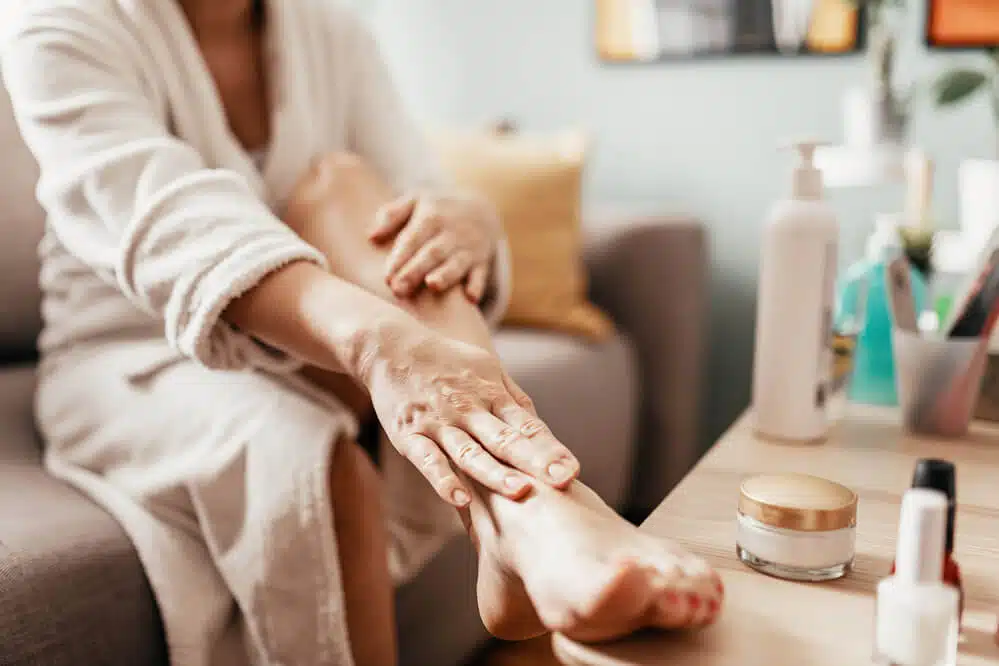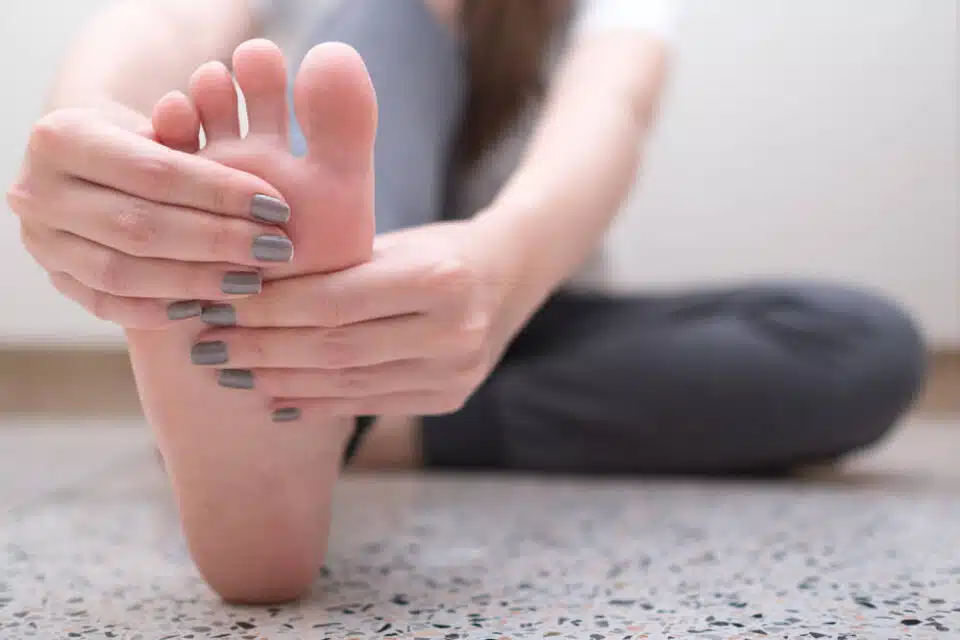Foot pain can disrupt your life and make even simple tasks challenging. Whether you’re dealing with soreness, aching arches, or general fatigue, there are several ways to prevent foot pain. So we asked the chiropodists at our Toronto foot clinic their top tips to prevent foot pain. These expert tips also work for a) preventing full-blown foot conditions that constantly flare up and affect your life; and b) preventing existing foot conditions from getting worse. From daily foot care to choosing the right footwear, these expert tips will help you maintain healthier, happier feet.
5 Expert Tips to Prevent Foot Pain
- Maintain Daily Foot Care
- Perform Light Foot Exercises and Stretches
- Wear the Right Footwear
- Consider Your Lifestyle
- See a Foot Specialist
1. Maintain Daily Foot Care

Daily foot care plays a critical role in preventing various foot issues and ensuring long-term comfort. Begin with moisturizing your feet regularly. Dry skin on the feet can lead to cracks and calluses, which not only cause pain but can also become a breeding ground for infections. Apply a moisturizing cream or lotion designed specifically for foot care after showering, as this helps lock in moisture and keeps the skin supple. It’s important to use a dedicated foot cream – not a body or facial moisturizer – as the skin on our feet is thicker and has unique needs due to the stress and weight of our movement.
To get double the results with one action, amp up your at-home foot care routine with a self-performed foot massage when you moisturize. Massaging the soles of your feet and gently stretching each toe helps to release tension and boost blood flow. The arch of the foot is often noted as the “sweet spot” during a foot massage since the arch muscles are some of the hardest working in the human body.
Massages can be especially beneficial if you spend long hours on your feet or wear tight shoes (but remember, you need to stop doing the latter!). If you find sore spots, spend a bit more time on those areas to ease discomfort and prevent future pain.
Additionally, a soothing foot bath can go a long way in alleviating stress and enhancing your foot health. Warm water (hot water can dry out your skin) with Epsom salts can help reduce inflammation and improve circulation in the feet. For an extra boost, consider adding essential oils like lavender or eucalyptus, which offer calming and antibacterial properties. However, the most bang-for-your-buck can be found in foot bath products come from companies like Gehwol. These contain both essential oils AND medicinal ingredients, and are available at our Toronto foot clinic.
2. Perform Light Foot Exercises and Stretches
Foot exercises and stretches are incredibly beneficial for keeping your feet limber and reducing stiffness. Incorporating gentle stretches can also help prevent foot injuries and make you less susceptible to other biomechanical conditions. Foot exercises work by maintaining flexibility and strength in the intrinsic and extensor muscles, tendons, and ligaments.
Some foot exercises are self-explanatory and very straight-forward, like ankle circles and towel curls. Ankle circles are perfect for improving range of motion; simply rotate each ankle clockwise and counterclockwise. For towel curls, place a towel on the floor and use your toes to scrunch it toward you. This simple exercise works the muscles on the underside of your feet.
For more specific guidance, take a look at these targeted exercises for common foot conditions:
- Best exercises for plantar fasciitis: These exercises focus on stretching the plantar fascia ligament, which often causes heel pain when inflamed.
- Best exercises for arthritis part 1 and 2: Aimed at maintaining mobility in the joints, these exercises help reduce stiffness and improve range of motion for individuals with arthritis.
- Best exercises for diabetes: Diabetic foot exercises promote circulation, which is crucial for managing foot health in individuals with diabetes, as they are more prone to infections and sores.
- Best exercises for bunions: These exercises can help strengthen the muscles around the big toe, improving alignment and reducing pressure on the bunion.
Adding these exercises to your routine can be instrumental in alleviating foot pain and keeping you active. Regularly performing these stretches will not only reduce discomfort but also prevent potential injuries by keeping your feet strong and resilient.
3. Wear The Right Footwear
Many people think foot pain is a normal part of life, and that ill-fitting shoes will not cause harm in the long run. None of this is true! Wearing appropriate footwear is perhaps one of the simplest yet most effective ways to prevent foot pain. There are 4 things to consider when selecting the right shoes: support, fit, purpose, and condition.
Support
Your feet bear the weight of your entire body, so providing them with the right support is essential. Shoes with adequate shock absorption help cushion the impact from the pavement, hard floors and ground when you walk or run, which reduces stress on all parts of the foot. Arch support is equally important; It distributes pressure evenly across your feet, minimizing strain on specific areas.
Fit
Ill-fitting shoes are a major cause of foot pain and can lead to conditions such as bunions, plantar fasciitis, and even arthritis. When shoes don’t fit properly, they can restrict movement and force your feet into unnatural positions, creating pressure points and friction.
To see if your shoes fit properly:
- Look for footwear that allows enough room for your toes to wiggle – ideally between ⅜” to ½” of space between the end of your longest toe and the front of the shoe.
- If you’re feeling your toes knocking against the front of your shoes, they’re too small. Conversely, if you’re feeling your shoe moving around and sliding as you walk, they’re too big.
- Loosen the laces if the shoes feel too tight. If that doesn’t work, look for a wide-width shoe; do not go up in length to accommodate width (you’ll just end up with a long narrow shoe).
- Always check the toe room when you’re standing – not sitting. Our feet splay when we stand, which affects how the shoe fits.
Activities
Selecting shoes tailored to your specific needs is key. For example, runners should look for high-quality athletic shoes while people who walk or stand for long periods may benefit from shoes that have a removable insole so they can wear custom orthotics at work. Whatever your lifestyle, investing in quality footwear is one of the best foot pain tips anyone can follow.
Wear-and-tear
Lastly, shoes aren’t meant to last forever, even the best ones. You may need to rotate them based on seasonality, or if you think your foot size may have changed. Either way, rotate your shoes regularly to avoid the wear-and-tear that causes discomfort over time.
4. Consider Your Lifestyle
Foot health tips only go so far if you don’t understand your lifestyle and its impact on your feet.
As previously mentioned, athletes need supportive athletic shoes. These shoes are designed for activities that involve running, jumping, or quick lateral movements. Without proper footwear, athletes risk overuse injuries like shin splints, Achilles tendonitis, plantar fasciitis or stress fractures, which can be both painful and debilitating.
Seniors or individuals with mobility concerns, on the other hand, may benefit from orthopaedic footwear. Orthopaedic shoes are designed to support the structure of the foot and can accommodate issues such as arthritis or diabetic neuropathy. These shoes often feature wider toe boxes, extra depth, extra cushioning, and removable insoles to ensure maximum comfort and stability. For seniors, having footwear that reduces the risk of falls is crucial in maintaining independence and mobility.
Professionals who spend long hours on their feet, such as nurses, restaurant workers, or flight attendants, may need compression stockings in addition to solid footwear. The opposite is also true: office workers or anyone who works in a sedentary position can also benefit from compression stockings. Compression stockings promote blood circulation, reducing the risk of swelling and fatigue. By combining supportive shoes with compression stockings, these folks can significantly reduce foot pain that comes from standing for hours on end.
By aligning your footwear choices with your daily activities, age or general lifestyle, you can not only prevent pain but also enhance your life experiences. If you find that a specific activity or aspect of your lifestyle is causing foot discomfort, consider getting a foot assessment with a chiropodist or podiatrist. At a foot assessment, you’ll get expert advice to ensure you’re taking the right steps to prevent foot pain. Which leads to our last tip to prevent foot pain:
5. See a Foot Specialist
The best way to prevent foot pain is to be proactive. Adding a foot specialist like a chiropodist or podiatrist to your health care team is one of the best ways to do that. A chiropodist can do the following:
- Routine foot care: This includes medical pedicures, corns, calluses and routine nail care. All of this is done in a safe, sterilized environment so you don’t need to worry about infection. A chiropodist will also trim your toenails so they don’t become ingrown, and will notice any problems you may not. The best part about seeing a chiropodist for foot care is that they can give you expert advice for taking care of your feet at home.
- Foot & Biomechanical Assessments: A chiropodist can do a biomechanical assessment and gait analysis to diagnose any potential foot concerns that can lead to pain. For instance, a chiropodist can see if you overpronate or have flat feet. You can then get expert advice to manage it so it doesn’t cause problems down the road. A chiropodist can also recommend footwear based on your foot type and gait pattern, as well as any exercises, stretches or devices that can help prevent foot pain.










